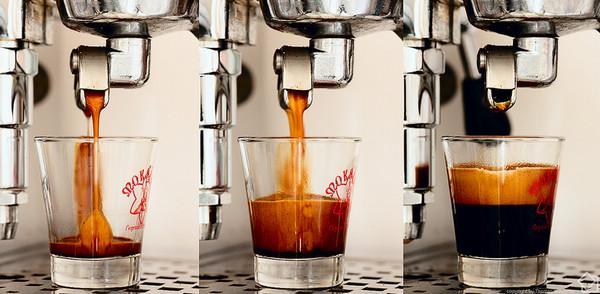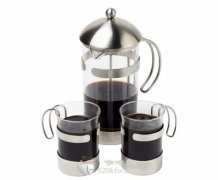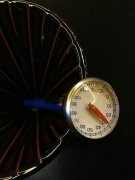Introduction to the concept of Espresso in boutique Coffee

In March 2000, it all started because Mark Prince, who was still very weak at that time, reposted a newspaper tidbit, discussing from the standard definition of espresso in Italy to the Italian experience of Mark, and finally someone moved out of the chapter in the Schomer book, and the topic suddenly turned to the noun ristretto. Just when everyone began to feel a little foggy and skeptical, Al Critzer (former illy USA, Cimbali) joined the discussion string, providing a summary of the results of a large number of tests by practitioners and annotating ristretto. It may not feel any special significance to him, because it is generally believed that this is not his original opinion (he also says This info was passed on to me by Dr. Illy and his disciples, so I guess it is an Italian way of thinking as well as the single most respected scientific mind in the field of espresso. ), he may just be a kind-hearted person who spreads information, but it is definitely a classic event of the online forum at that time. He told a lot of people who are passionate about coffee but lack the right theoretical basis, a catchy formula. The paragraphs he said, which have been honed over the years, are not only the most common concept of espresso in Europe and the United States, but also almost all the extraction documents that can be seen on the Internet are based on this as a model, known as: Al's Rule,
The original text is as follows:
It seems that everyone's close, but pretty much all around it. As I was trained, the perfect espresso is 30ml in 30sec. That's assuming that all other factors are in line. For longer extractions, the contact time of water to coffee would have to be lessened so that undesirable elements associated with overextraction wouldn't be present in the cup. With shorter extractions, the water to coffee contact time would have to be increased to ensure that underextraction doesn't occur. This is accomplished by grind adjustment. A good rule of thumb I have developed is this: For every 5ml of espresso above 30ml, subtract 1 sec of extract time. By this formula 1 1/2oz (45ml) would require 27sec extraction, 2oz (60ml) would require 24sec, etc. The same holds true in reverse. This will find the sweet spot in espresso regardless of volume in the cup (within reasonable limits of .75oz to 2.5oz), as you are optimizing extraction to the desirable elements, maintaining the balance between under- and overextraction. For some reason, grinder adjustment and it's crucial impact on espresso is the most difficult concept to explain and grasp in all the trainings I do.
To the effect that
Start with the result that 30cc/ 30sec gets a perfect Espresso. These two values of course depend on beans, and the differences in baking method, baking degree and formula ratio will naturally lead to changes in the reference point.
The amount of extraction is inversely proportional to the extraction time.
The more the amount of extraction, the shorter the contact time between coffee powder and hot water (avoid over-extraction).
On the contrary, when the amount of extraction is reduced, the contact time between coffee powder and water should be increased (to avoid insufficient extraction)
Al formula: when the extraction amount of 5cc is increased, the extraction time should be subtracted from 1sec. On the contrary, add 1sec.
For example, when the amount of extraction increases to 45cc, 30-(45-30) / 527, the extraction time is reduced to 27sec.
When the extraction amount is 60cc, the extraction time becomes 24sec.
Within the reasonable limit of 0.75-2.5oz Espresso, this formula can quickly and correctly hunt sweet spots (Sweet Spot), effectively catch satisfactory ingredients, and maintain a scary balance between over-extraction and under-extraction. The main means of control is to adjust the grinding thickness.
As for the controversial definition of ristretto at that time, Al Critzer also gave his explanation by the way:
As to ristretto. This a different drink altogether. If your grinder is set for regular espresso, and you choose to stop the pour at 25ml, this is simply an underextracted espresso. You haven't hit the sweet spot yet. The "restricted" part referred to as ristretto is not so much related to volume as it is to water flow through the coffee puck. The ristretto that has been used for cuppings is a 25ml cup in 30-35sec. This extraction intensifies the organoleptic perceptions of the eyes, nose, taste buds and upper pallate to better isolate the positive attributes of a given blend. Where the positives are accentuated, the negatives are exacerbated as well. The extractions are characterized by a very thin mouse's tail with rich, dark brown crema. Most people don't drink this as their everyday drink, but it is helpful in developing blends. If you customarily drink 25ml (or 50ml doubles), your grinder should be adjusted accordingly. Damn, I did it again... .
Ristretto is a very different drink from normal espresso.
If the grinding is constant and the extraction is finished early at the normal espresso flow rate, for example, at the original 30sec/ 30cc flow rate, only 25cc is taken, which is the result of insufficient extraction in a cup, because the sweet point has not yet been reached.
The so-called ristretto means restricted, and the customary practice is 25cc/ 30-35sec.
All sensory sensations, including what the eyes see, what the nose smells, and what the tongue tastes, whether it's good or bad, are aggravated.
Ristretto is characterized by a very thin mouse tail with a darker brown crema.
Most people don't drink this stuff every day, but it's good for blend, which is still in development.
If you are the one who is used to drinking ristretto, whether it is 25cc or 50cc, then your grinding should be adjusted accordingly. How to adjust? It's the same, Al' Rule. Let's start over.
Al Critzer was discussing another conversation between Chuanli and the well-known industry Dr. Joseph John (Josuma Coffee Company) is also a classic:
Dr John,
You didn't mention if this was done with the single filter or double. I don't know. 39% hoping it was with the single. I personally am of the opinion that any espresso (single) should not be less than 25ml. A 1x2 oz (15ml) espresso has proved impossible for me to make in any drinkable state.
Here Al is equivalent to reiterating that his formula is at the beginning of setting work, using the data made by single basket as the basis for inference. That is, even if your store usually uses the double filter to make cups, the single filter is still the set benchmark. In his personal experience, no espresso (single) should be less than 25cc. For him, a glass of 15cc espresso is unable to reach the "drinkable" state (the word drinkable is still a long way from being good), which is tantamount to giving advance advice to some people who like 30cc double ristretto later.
Important Notice :
前街咖啡 FrontStreet Coffee has moved to new addredd:
FrontStreet Coffee Address: 315,Donghua East Road,GuangZhou
Tel:020 38364473
- Prev

History of Coffee utensils History of pressing pots
The French pressure kettle is a very personalized, very simple, full of fun, more practical things. French press has always been said to be the best endorsement for lazy coffee, but it still has a huge following. Frenchpress's fans all said that frenchpress is the maker that can best reflect the original taste of coffee, because coffee can be bloomed in the easiest way.
- Next

Summary of the main points of hand-brewed coffee
The temperature of brewing coffee is 83 ℃ at the moment of brewing, 80 ℃ when it is poured into the cup, and 61 ℃-62 ℃ when it is in the mouth, which is ideal. It is said that coffee is like life, only when it is carefully prepared can it have the desired taste and strong fragrance, and only when you taste it with your heart can you really realize the taste. If you don't know how to mix it, this cup of coffee will always be bitter.
Related
- Beginners will see the "Coffee pull flower" guide!
- What is the difference between ice blog purified milk and ordinary milk coffee?
- Why is the Philippines the largest producer of crops in Liberia?
- For coffee extraction, should the fine powder be retained?
- How does extracted espresso fill pressed powder? How much strength does it take to press the powder?
- How to make jasmine cold extract coffee? Is the jasmine + latte good?
- Will this little toy really make the coffee taste better? How does Lily Drip affect coffee extraction?
- Will the action of slapping the filter cup also affect coffee extraction?
- What's the difference between powder-to-water ratio and powder-to-liquid ratio?
- What is the Ethiopian local species? What does it have to do with Heirloom native species?

